tire size MINI Countryman 2012 Owner's Manual (Mini Connected)
[x] Cancel search | Manufacturer: MINI, Model Year: 2012, Model line: Countryman, Model: MINI Countryman 2012Pages: 259, PDF Size: 3.07 MB
Page 79 of 259
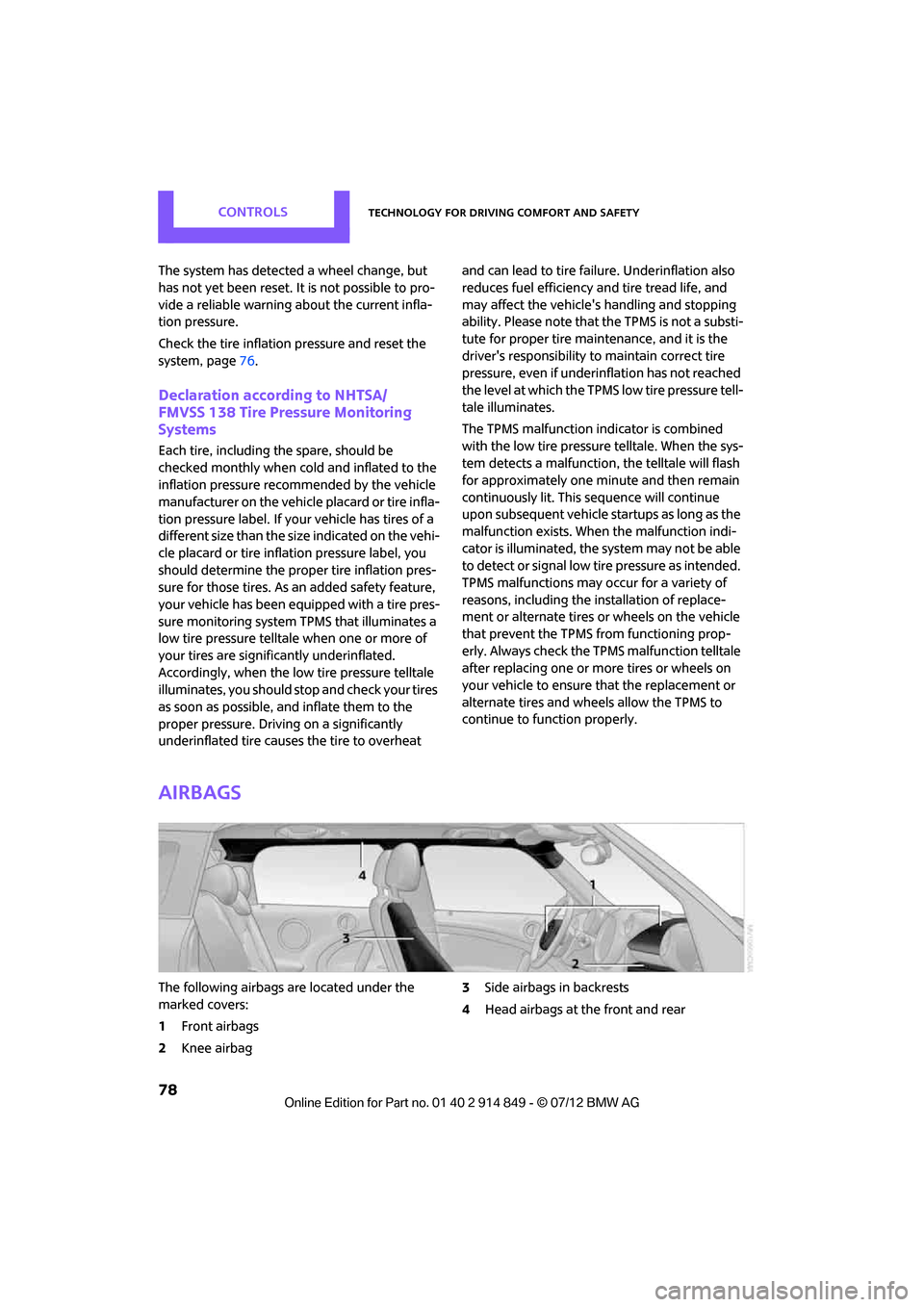
CONTROLSTechnology for driving comfort and safety
78
The system has detected a wheel change, but
has not yet been reset. It is not possible to pro-
vide a reliable warning about the current infla-
tion pressure.
Check the tire inflation pressure and reset the
system, page 76.
Declaration according to NHTSA/
FMVSS 138 Tire Pressure Monitoring
Systems
Each tire, including the spare, should be
checked monthly when cold and inflated to the
inflation pressure recommended by the vehicle
manufacturer on the vehicle placard or tire infla-
tion pressure label. If your vehicle has tires of a
different size than the size indicated on the vehi-
cle placard or tire inflation pressure label, you
should determine the proper tire inflation pres-
sure for those tires. As an added safety feature,
your vehicle has been equipped with a tire pres-
sure monitoring system TPMS that illuminates a
low tire pressure telltal e when one or more of
your tires are significantly underinflated.
Accordingly, when the low tire pressure telltale
illuminates, you should st op and check your tires
as soon as possible, and inflate them to the
proper pressure. Driving on a significantly
underinflated tire causes the tire to overheat and can lead to tire failure. Underinflation also
reduces fuel efficiency and tire tread life, and
may affect the vehicle's handling and stopping
ability. Please note that the TPMS is not a substi-
tute for proper tire maintenance, and it is the
driver's responsibility to
maintain correct tire
pressure, even if underi nflation has not reached
the level at which the TPMS low tire pressure tell-
tale illuminates.
The TPMS malfunction indicator is combined
with the low tire pressure telltale. When the sys-
tem detects a malfunction, the telltale will flash
for approximately one minute and then remain
continuously lit. This sequence will continue
upon subsequent vehicle startups as long as the
malfunction exists. When the malfunction indi-
cator is illuminated, the system may not be able
to detect or signal low tire pressure as intended.
TPMS malfunctions may occur for a variety of
reasons, including the installation of replace-
ment or alternate tires or wheels on the vehicle
that prevent the TPMS from functioning prop-
erly. Always check the TP MS malfunction telltale
after replacing one or mo re tires or wheels on
your vehicle to ensure that the replacement or
alternate tires and wheels allow the TPMS to
continue to function properly.
Airbags
The following airbags are located under the
marked covers:
1 Front airbags
2 Knee airbag 3
Side airbags in backrests
4 Head airbags at the front and rear
Online Edition for Part no. 01 40 2 914 849 - \251 07/12 BMW AG
Page 81 of 259
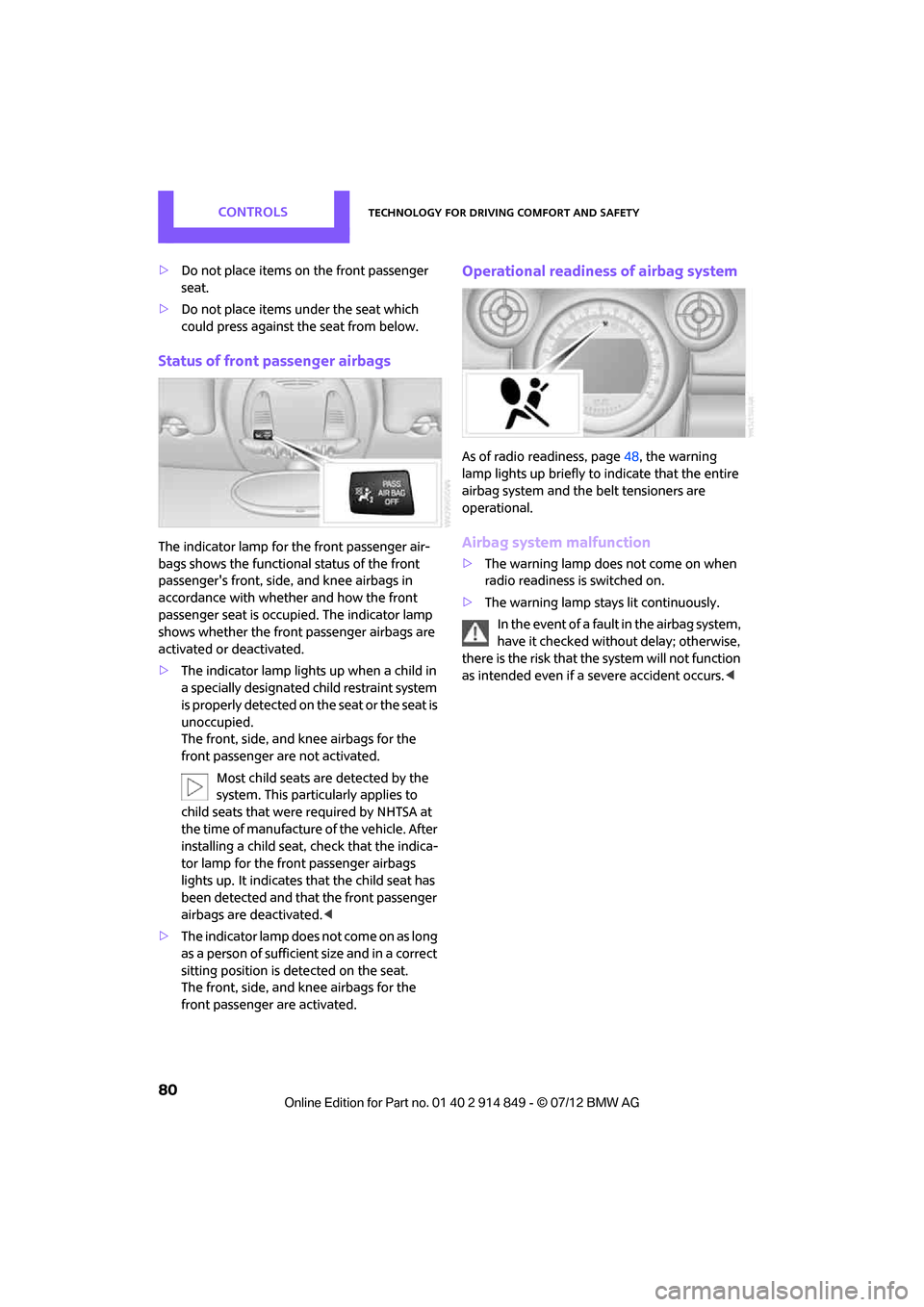
CONTROLSTechnology for driving comfort and safety
80
>Do not place items on the front passenger
seat.
> Do not place items under the seat which
could press against the seat from below.
Status of front passenger airbags
The indicator lamp for the front passenger air-
bags shows the functional status of the front
passenger's front, side, and knee airbags in
accordance with whether and how the front
passenger seat is occupied. The indicator lamp
shows whether the front passenger airbags are
activated or deactivated.
> The indicator lamp lights up when a child in
a specially designated child restraint system
is properly detected on the seat or the seat is
unoccupied.
The front, side, and knee airbags for the
front passenger are not activated.
Most child seats are detected by the
system. This particularly applies to
child seats that were required by NHTSA at
the time of manufacture of the vehicle. After
installing a child seat, check that the indica-
tor lamp for the front passenger airbags
lights up. It indicates that the child seat has
been detected and that the front passenger
airbags are deactivated. <
> T h e i n d i c a t o r l a m p d o e s n o t c o m e o n a s l o n g
as a person of sufficient size and in a correct
sitting position is detected on the seat.
The front, side, and knee airbags for the
front passenger are activated.
Operational readines s of airbag system
As of radio readiness, page 48, the warning
lamp lights up briefly to indicate that the entire
airbag system and the belt tensioners are
operational.
Airbag system malfunction
> The warning lamp does not come on when
radio readiness is switched on.
> The warning lamp stays lit continuously.
In the event of a fault in the airbag system,
have it checked without delay; otherwise,
there is the risk that the system will not function
as intended even if a severe accident occurs. <
Online Edition for Part no. 01 40 2 914 849 - \251 07/12 BMW AG
Page 197 of 259
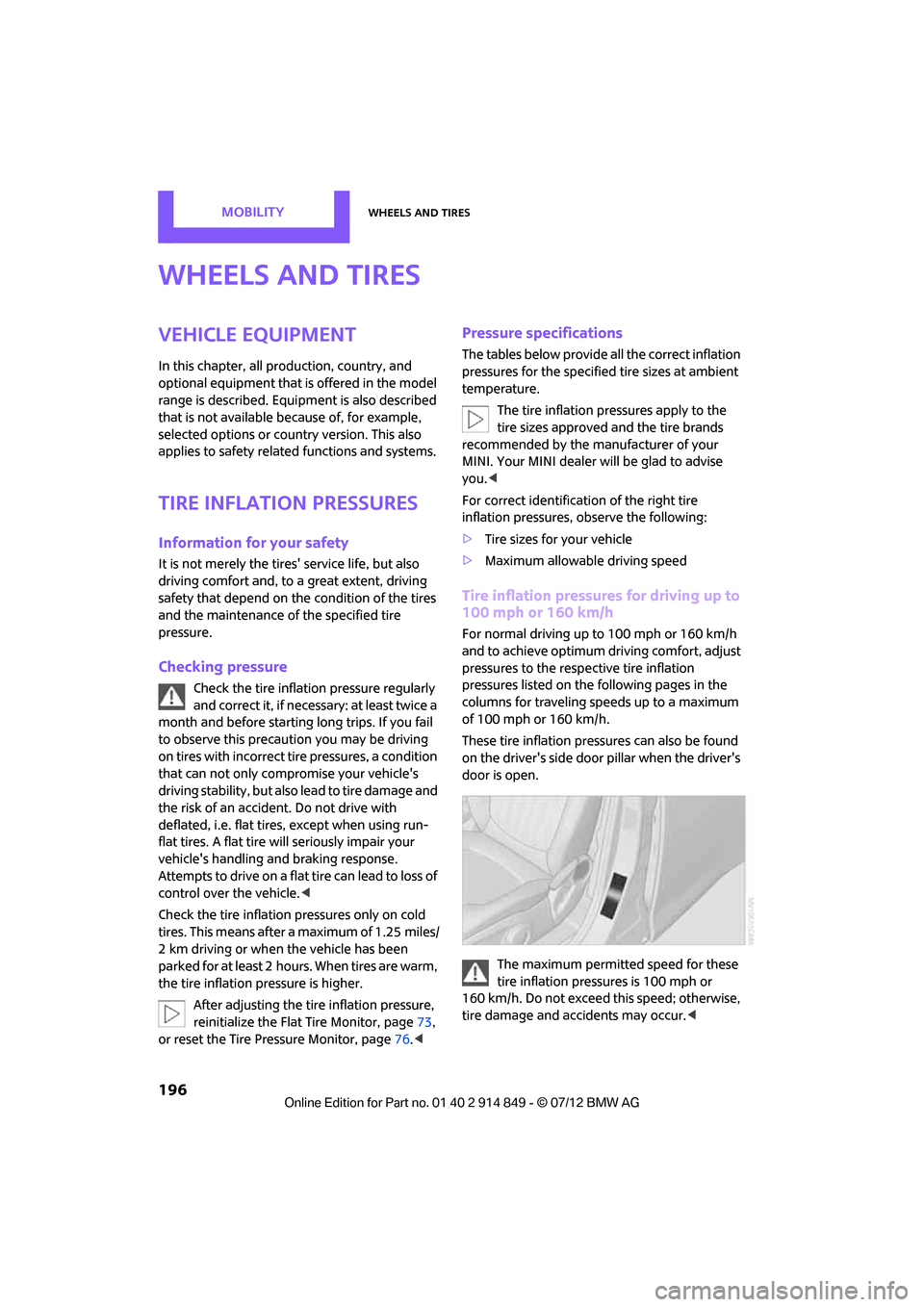
MOBILITYWheels and tires
196
Wheels and tires
Vehicle equipment
In this chapter, all production, country, and
optional equipment that is offered in the model
range is described. Equipment is also described
that is not available because of, for example,
selected options or coun try version. This also
applies to safety relate d functions and systems.
Tire inflation pressures
Information for your safety
It is not merely the tire s' service life, but also
driving comfort and, to a great extent, driving
safety that depend on the condition of the tires
and the maintenance of the specified tire
pressure.
Checking pressure
Check the tire inflation pressure regularly
and correct it, if necessary: at least twice a
month and before starting long trips. If you fail
to observe this precauti on you may be driving
on tires with incorrect ti re pressures, a condition
that can not only compromise your vehicle's
driving stability, but also l e a d t o t i r e d a m a g e a n d
the risk of an accident. Do not drive with
deflated, i.e. flat tires, except when using run-
flat tires. A flat tire will seriously impair your
vehicle's handling and braking response.
Att empt s to drive o n a flat t ire can lead to lo ss of
control over the vehicle. <
Check the tire inflation pressures only on cold
tires. This means after a maximum of 1.25 miles/
2 km driving or when the vehicle has been
parked for at least 2 hou rs. When tires are warm,
the tire inflation pressure is higher.
After adjusting the tire inflation pressure,
reinitialize the Flat Tire Monitor, page 73,
or reset the Tire Pressure Monitor, page 76.<
Pressure specifications
The tables below provide all the correct inflation
pressures for the specified tire sizes at ambient
temperature.
The tire inflation pressures apply to the
tire sizes approved and the tire brands
recommended by the manufacturer of your
MINI. Your MINI dealer will be glad to advise
you. <
For correct identificati on of the right tire
inflation pressures, observe the following:
> Tire sizes for your vehicle
> Maximum allowable driving speed
Tire inflation pressures for driving up to
100 mph or 160 km/h
For normal driving up to 100 mph or 160 km/h
and to achieve optimum driving comfort, adjust
pressures to the respective tire inflation
pressures listed on the following pages in the
columns for traveling sp eeds up to a maximum
of 100 mph or 160 km/h.
These tire inflation pre ssures can also be found
on the driver's side door pillar when the driver's
door is open.
The maximum permitted speed for these
tire inflation pressures is 100 mph or
160 km/h. Do not exceed this speed; otherwise,
tire damage and accidents may occur. <
Online Edition for Part no. 01 40 2 914 849 - \251 07/12 BMW AG
Page 199 of 259

MOBILITYWheels and tires
198
Tire inflation pressures MINI Cooper Countryman
Tire size Tire pressures in bar/psi
Speeds up to a max. of 100 mph/160 km/h Speeds including those
exceeding
100 mph/160 km/h
All pressure specifications in the
table are indicated in bar/psi for
cold tires. Cold = ambient
temperature
195/60 R 16 89 H M+S
205/55 R 17 91 H M+S
205/55 R 17 91 H M+S RSC
205/55 R 17 91 V RSC
225/45 R 18 91 V RSC
225/40 R 19 89 V RSC 2.2/32 2.2/32 2.4/35 2.4/35
More details on the permissible load and weights can be found on page234.
Online Edition for Part no. 01 40 2 914 849 - \251 07/12 BMW AG
Page 200 of 259

Wheels and tiresMOBILITY
199
Tire inflation pressures MINI Cooper S Countryman / Cooper S ALL4 Countryman
Tire size Tire pressures in bar/psi
Speeds up to a max. of 100 mph/160 km/h Speeds including those
exceeding
100 mph/160 km/h
All pressure specifications in the
table are indicated in bar/psi for
cold tires. Cold = ambient
temperature
195/60 R 16 89 H M+S
205/55 R 17 91 H M+S
205/55 R 17 91 H M+S RSC
205/55 R 17 91 V RSC
225/45 R 18 91 V RSC
225/40 R 19 89 V RSC 2.2/32 2.2/32 2.6/38 2.6/38
More details on the perm issible load and weights can be found on page 234.
Online Edition for Part no. 01 40 2 914 849 - \251 07/12 BMW AG
Page 201 of 259
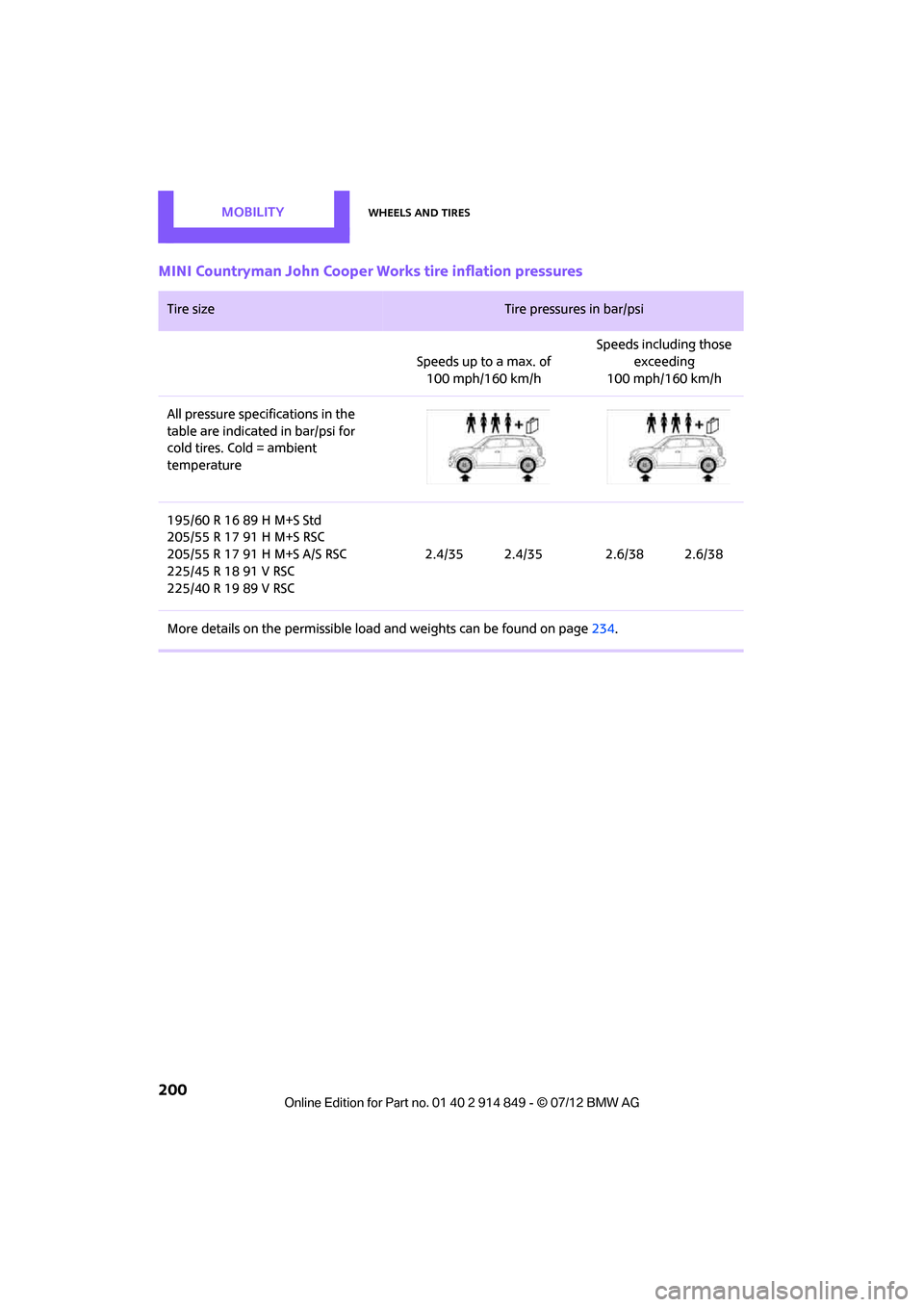
MOBILITYWheels and tires
200
MINI Countryman John Cooper Works tire inflation pressures
Tire size Tire pressures in bar/psi
Speeds up to a max. of 100 mph/160 km/h Speeds including those
exceeding
100 mph/160 km/h
All pressure specifications in the
table are indicated in bar/psi for
cold tires. Cold = ambient
temperature
195/60 R 16 89 H M+S Std
205/55 R 17 91 H M+S RSC
205/55 R 17 91 H M+S A/S RSC
225/45 R 18 91 V RSC
225/40 R 19 89 V RSC 2.4/35 2.4/35 2.6/38 2.6/38
More details on the permissible load and weights can be found on page234.
Online Edition for Part no. 01 40 2 914 849 - \251 07/12 BMW AG
Page 202 of 259

Wheels and tiresMOBILITY
201
Tire identification marks
Knowledge of the labeling on the side of the tire
makes it easier to identify and choose the right
tires.
Tire size
Speed letter
Q = up to 100 mph/160 km/h
T = up to 118 mph/190 km/h
H = up to 131 mph/210 km/h
V = up to 150 mph/240 km/h
W = up to 167 mph/270 km/h
Y = up to 186 mph/300 km/h
Tire Identification Number
Tires with DOT codes meet the guidelines of the
US Department of Transportation.
DOT code:
Uniform Tire Quality Grading
Quality grades can be found where applicable
on the tire sidewall between tread shoulder and
maximum section width. For example:
Tread wear 200 Traction AA
Temperature A
DOT Quality Grades
Tread wear
Traction AA A B C
Temperature A B C
All passenger car tires must conform to
Federal Safety Requirements in addition
to these grades. <
Tread wear
The tread wear grade is a comparative rating
based on the wear rate of the tire when tested
under controlled conditions on a specified gov-
ernment test course. For example, a tire graded
150 would wear one and one-half (1 γ) times as
well on the government course as a tire graded
100. The relative performance of tires depends
upon the actual conditions of their use, how-
ever, and may depart si gnificantly from the
norm due to variations in driving habits, service
practices and differences in road characteristics
and climate.
Traction
The traction grades, from highest to lowest, are
AA, A, B, and C.
Those grades represent the tire's ability to stop
on wet pavement, as measured under con-
trolled conditions on specified government test
surfaces of asphalt and concrete. A tire marked C
may have poor traction performance.
The traction grade assigned to this tire is
based on straight-ahead braking traction
tests, and does not include acceleration,
cornering, hydroplaning, or peak traction
characteristics. <
Temperature
The temperature grades are A, the highest, B,
and C, representing the tire's resistance to the
generation of heat and its ability to dissipate
heat when tested under controlled conditions
on a specified indoor labo ratory test wheel. Sus-
tained high temperature can cause the material
of the tire to degenerate and reduce tire life, and
excessive temperature can lead to sudden tire
e.g.
Nominal width in mm
Aspect
ratio in Ξ
Radial belt construction
Rim diameter in inches
Load rating,
(not on ZR tires)
Speed code letter,
(before the R on ZR tires)
225/45 R 17 91 V
For instance:
Manufacturer's code
for tire make
tire size and
tire design
Tire ageDOT xxxx xxx 1012
Online Edition for Part no. 01 40 2 914 849 - \251 07/12 BMW AG
Page 205 of 259
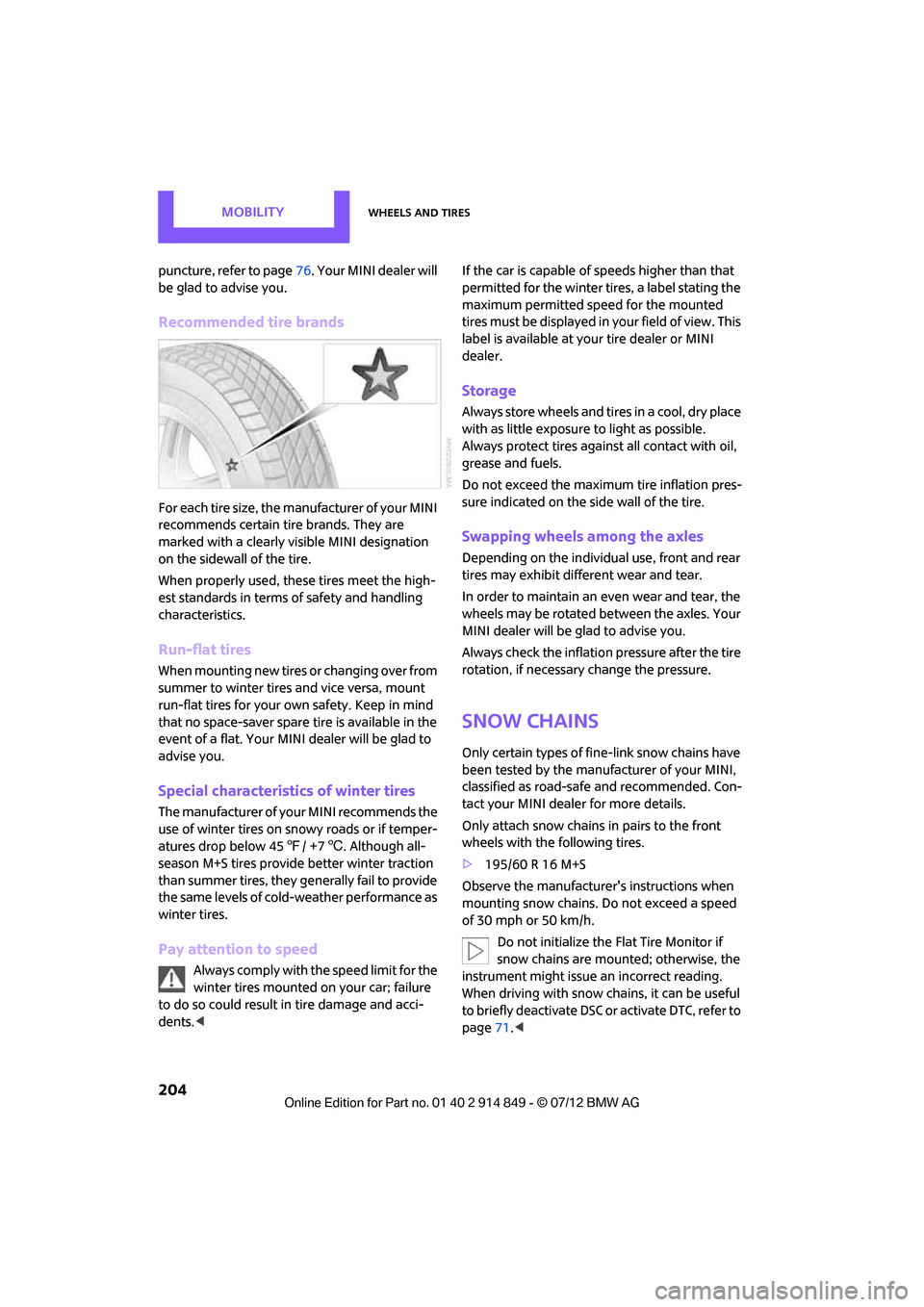
MOBILITYWheels and tires
204
puncture, refer to page76. Your MINI dealer will
be glad to advise you.
Recommended tire brands
For each tire size, the manufacturer of your MINI
recommends certain tire brands. They are
marked with a clearly vi sible MINI designation
on the sidewall of the tire.
When properly used, these tires meet the high-
est standards in terms of safety and handling
characteristics.
Run-flat tires
When mounting new tires or changing over from
summer to winter tires and vice versa, mount
run-flat tires for your ow n safety. Keep in mind
that no space-saver spare tire is available in the
event of a flat. Your MINI dealer will be glad to
advise you.
Special characteristics of winter tires
The manufacturer of your MINI recommends the
use of winter tires on snowy roads or if temper-
atures drop below 45 7/ +7 6. Although all-
season M+S tires provide better winter traction
than summer tires, they generally fail to provide
the same levels of cold-weather performance as
winter tires.
Pay attention to speed
Always comply with the speed limit for the
winter tires mounted on your car; failure
to do so could result in tire damage and acci-
dents. < If the car is capable of speeds higher than that
permitted for the winter tires, a label stating the
maximum permitted speed for the mounted
tires must be displayed in
your field of view. This
label is available at your tire dealer or MINI
dealer.
Storage
Always store wheels and tires in a cool, dry place
with as little exposure to light as possible.
Always protect tires agains t all contact with oil,
grease and fuels.
Do not exceed the maximum tire inflation pres-
sure indicated on the side wall of the tire.
Swapping wheels among the axles
Depending on the individual use, front and rear
tires may exhibit different wear and tear.
In order to maintain an even wear and tear, the
wheels may be rotated between the axles. Your
MINI dealer will be glad to advise you.
Always check the inflation pressure after the tire
rotation, if necessary change the pressure.
Snow chains
Only certain types of fine-link snow chains have
been tested by the manufacturer of your MINI,
classified as road-safe and recommended. Con-
tact your MINI dealer for more details.
Only attach snow chains in pairs to the front
wheels with the following tires.
>195/60 R 16 M+S
Observe the manufacturer's instructions when
mounting snow chains. Do not exceed a speed
of 30 mph or 50 km/h. Do not initialize the Flat Tire Monitor if
snow chains are mounted; otherwise, the
instrument might issue an incorrect reading.
When driving with snow ch ains, it can be useful
to briefly deactivate DSC or activate DTC, refer to
page 71.<
Online Edition for Part no. 01 40 2 914 849 - \251 07/12 BMW AG
Page 255 of 259
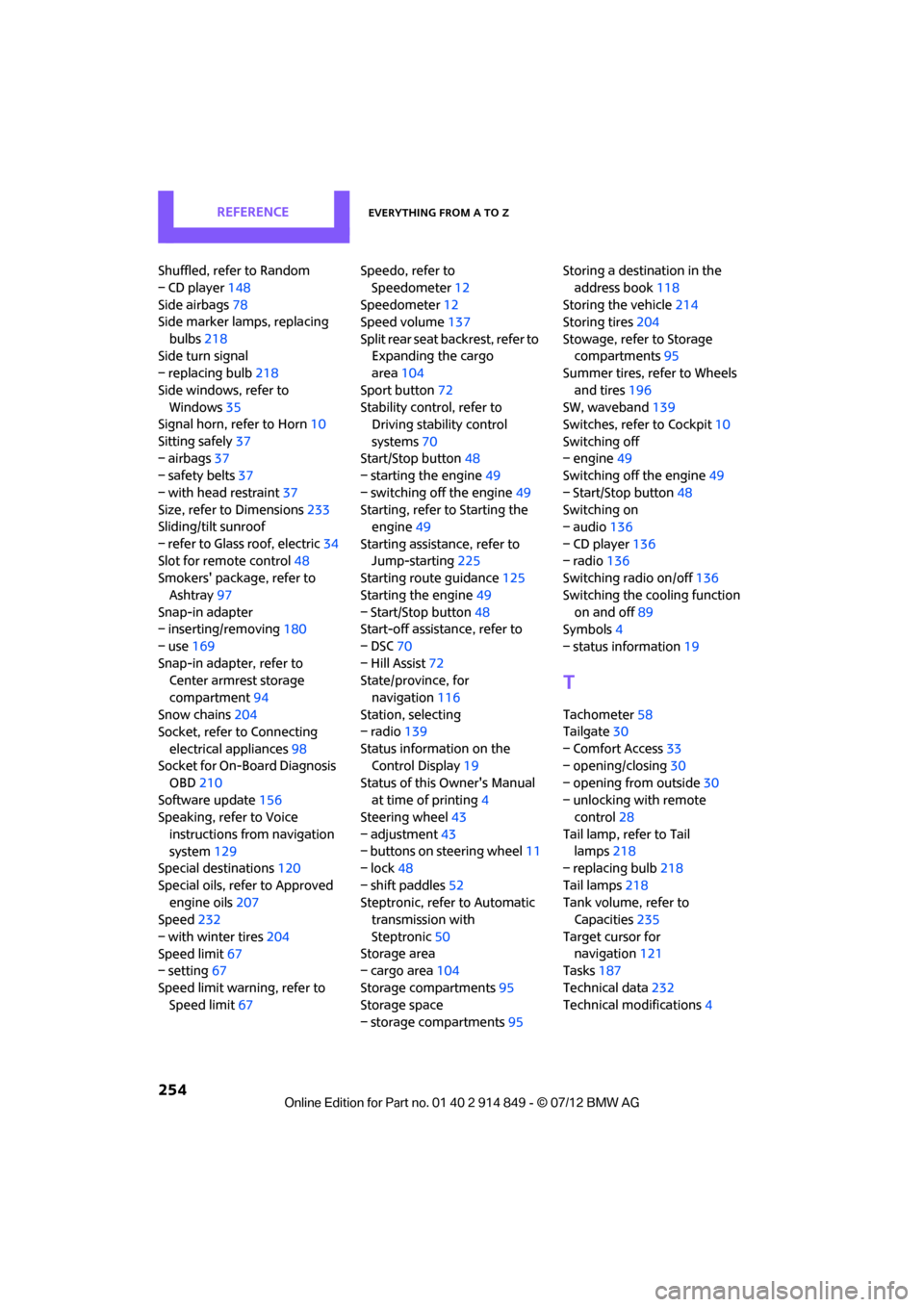
REFERENCEEverything from A to Z
254
Shuffled, refer to Random
– CD player148
Side airbags 78
Side marker lamps, replacing
bulbs 218
Side turn signal
– replacing bulb 218
Side windows, refer to Windows 35
Signal horn, refer to Horn 10
Sitting safely 37
– airbags 37
– safety belts 37
– with head restraint 37
Size, refer to Dimensions 233
Sliding/tilt sunroof
– refer to Glass roof, electric 34
Slot for remote control 48
Smokers' package, refer to
Ashtray 97
Snap-in adapter
– inserting/removing 180
– use 169
Snap-in adapter, refer to Center armrest storage
compartment 94
Snow chains 204
Socket, refer to Connecting
electrical appliances 98
Socket for On-Board Diagnosis
OBD 210
Software update 156
Speaking, refer to Voice
instructions from navigation
system 129
Special destinations 120
Special oils, refer to Approved engine oils 207
Speed 232
– with winter tires 204
Speed limit 67
– setting 67
Speed limit warning, refer to Speed limit 67 Speedo, refer to
Speedometer 12
Speedometer 12
Speed volume 137
Split rear seat backrest, refer to Expanding the cargo
area 104
Sport button 72
Stability contro l, refer to
Driving stability control
systems 70
Start/Stop button 48
– starting the engine 49
– switching off the engine 49
Starting, refer to Starting the engine 49
Starting assistance, refer to Jump-starting 225
Starting route guidance 125
Sta r
ti
ng the engine 49
– Start/Stop button 48
Start-off assistance, refer to
– DSC 70
– Hill Assist 72
State/province, for
navigation 116
Station, selecting
– radio 139
Status information on the Control Display 19
Status of this Owner's Manual at time of printing 4
Steering wheel 43
– adjustment 43
– buttons on steering wheel 11
– lock 48
– shift paddles 52
Steptronic, refer to Automatic transmission with
Steptronic 50
Storage area
– cargo area 104
Storage compartments 95
Storage space
– storage compartments 95Storing a destination in the
address book 118
Storing the vehicle 214
Storing tires 204
Stowage, refer to Storage compartments 95
Summer tires, refer to Wheels
and tires 196
SW, waveband 139
Switches, refer to Cockpit 10
Switching off
– engine 49
Switching off the engine 49
– Start/Stop button 48
Switching on
– audio 136
– CD player 136
– radio 136
Switching radio on/off 136
Switching the cooling function on and off 89
Symbols 4
– status information 19
T
Tachometer58
Tailgate 30
– Comfort Access 33
– opening/closing 30
– opening from outside 30
– unlocking with remote control 28
Tail lamp, refer to Tail lamps 218
– replacing bulb 218
Tail lamps 218
Tank volume, refer to Capacities 235
Target cursor for navigation 121
Tasks 187
Technical data 232
Technical modifications 4
Online Edition for Part no. 01 40 2 914 849 - \251 07/12 BMW AG
Page 256 of 259
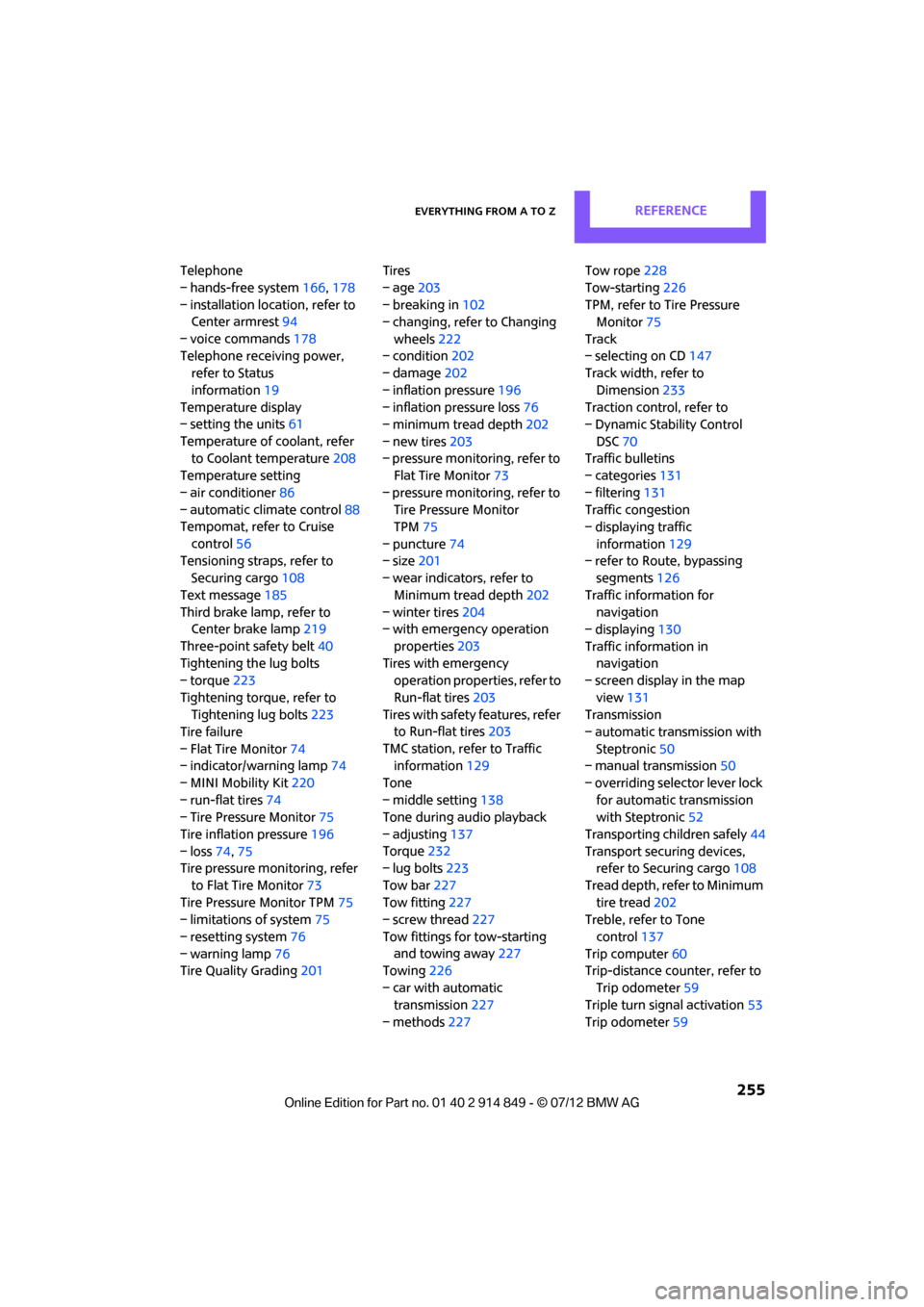
Everything from A to ZREFERENCE
255
Telephone
– hands-free system166,178
– installation location, refer to Center armrest 94
– voice commands 178
Telephone receiving power, refer to Status
information 19
Temperature display
– setting the units 61
Temperature of coolant, refer to Coolant temperature 208
Temperature setting
– air conditioner 86
– automatic climate control 88
Tempomat, refer to Cruise
control 56
Tensioning straps, refer to Securing cargo 108
Text message 185
Third brake lamp, refer to Center brake lamp 219
Three-point safety belt 40
Tightening the lug bolts
– torque 223
Tightening torque, refer to Tightening lug bolts 223
Tire failure
– Flat Tire Monitor 74
– indicator/warning lamp 74
– MINI Mobility Kit 220
– run-flat tires 74
– Tire Pressure Monitor 75
Tire inflation pressure 196
– loss 74,75
Tire pressure monitoring, refer
to Flat Tire Monitor 73
Tire Pressure Monitor TPM 75
– limitations of system 75
– resetting system 76
– warning lamp 76
Tire Quality Grading 201Tires
– age
203
– breaking in 102
– changing, refe r to Changing
wheels 222
– condition 202
– damage 202
– inflation pressure 196
– inflation pressure loss 76
– minimum tread depth 202
– new tires 203
– pressure monitoring, refer to Flat Tire Monitor 73
– pressure monitoring, refer to Tire Pressure Monitor
TPM 75
– puncture 74
– size 201
– we ar
indicators, refer to
Minimum tread depth 202
– winter tires 204
– with emergency operation
properties 203
Tires with emergency operation properties, refer to
Run-flat tires 203
Tires with safety features, refer
to Run-flat tires 203
TMC station, refer to Traffic information 129
Tone
– middle setting 138
Tone during audio playback
– adjusting 137
Torque 232
– lug bolts 223
Tow bar 227
Tow fitting 227
– screw thread 227
Tow fittings for tow-starting and towing away 227
Towing 226
– car with automatic transmission 227
– methods 227 Tow rope
228
Tow-starting 226
TPM, refer to Tire Pressure Monitor 75
Track
– selecting on CD 147
Track width, refer to
Dimension 233
Traction control, refer to
– Dynamic Stability Control
DSC 70
Traffic bulletins
– categories 131
– filtering 131
Traffic congestion
– displaying traffic
information 129
– refer to Route, bypassing segments 126
Traffic information for navigation
– displaying 130
Traffic information in navigation
– screen display in the map
view 131
Transmission
– automatic transmission with
Steptronic 50
– manual transmission 50
– overriding selector lever lock for automatic transmission
with Steptronic 52
Transporting children safely 44
Transport securing devices, refer to Securing cargo 108
Tread depth, refer to Minimum tire tread 202
Treble, refer to Tone
control 137
Trip computer 60
Trip-dist a
n
ce counter, refer to
Trip odometer 59
Triple turn signal activation 53
Trip odometer 59
Online Edition for Part no. 01 40 2 914 849 - \251 07/12 BMW AG